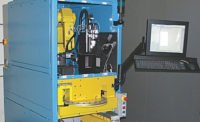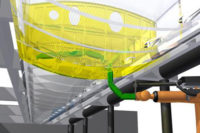Fixtures, Mobile Robots Ease Assembly of Jet Wings




Developing new aircraft is always a challenge, but one that engineers at Gulfstream Aerospace Corp. (GAC) have successfully dealt with for more than 60 years. GAC produces state-of-the-art corporate jets for companies and governments all around the world, with hundreds of them currently in operation.
Back in early 2015, GAC workers at the company’s main plant in Savannah, GA, had trouble assembling the wings of the then-in-development G500 and G600 jets. This situation led company manangement to reach out to Sterling Heights, MI-based KUKA Systems North America LLC for help.
KUKA provided GAC with custom fixtures and two mobile robot platforms to help workers complete the assembly of jet wings and other components. Each fixture is a long, vertical structure that is larger than the wing itself. Inside this structure, the wing ribs and spars are installed between the top and bottom skins to provide needed structural integrity.
One type of fixture tooling vertically lifts each wing, turns it to the horizontal position and moves it to the next assembly station. Other tooling helps workers locate, hold and assemble various wing sections, such as ailerons, engine-mount bulkheads, flaps, and leading and trailing edge panels.
All tooling is designed to Gulstream’s engineering specifications for each aircraft type, and made with large parts that are fabricated and machined to tight tolerances. Multiple processes are used in fabrication, depending on the tool type and its function.
Typically, the main structure is made of steel, usually tubing, while part-touching details or critical locators are made of aluminum. Some tools may be made entirely of aluminum so the coefficient of thermal expansion matches that of the aluminum aircraft parts being assembled.
The robot platforms are the first such platforms made by any manufacturer in the United States, according to Larry Drake, CEO of KUKA Systems North America. Both platforms enable precise drilling and fastening, with excellent repeatability, to increase assembly productivity and improve part quality.
Each platform includes a KUKA robot and a KUKA multi-function end effector. For Gulfstream, the robots drill primarily on the wing and horizontal stabilizer structures, including sections containing titanium that are difficult to manually drill.
“Every large order KUKA has done for an aerospace customer has included substantial tooling,” says Drake. “Our ability to build excellent aerospace assembly fixtures now is well accepted in the industry.”
Prototype models of the G500 and G600 were unveiled to the public in October 2014 after extensive development, assembly and testing. The first flight of the G500 took place May 18, 2015, while the G600 had its maiden flight on Dec. 17, 2016. The jets began commercial flights on Sept. 27, 2018, and Aug. 8, 2019, respectively.
Part of Germany-based KUKA AG, KUKA Systems is an international supplier of engineering services and flexible automation systems for the aerospace, automotive and energy industries. The company’s 5,800 employees worldwide develop automated systems that produce parts and subassemblies made of metallic and nonmetallic materials.
For more information on aerospace fixtures, tooling and mobile robot platforms, call 586-795-2000 or visit www.kuka-systems.com.
Looking for a reprint of this article?
From high-res PDFs to custom plaques, order your copy today!








